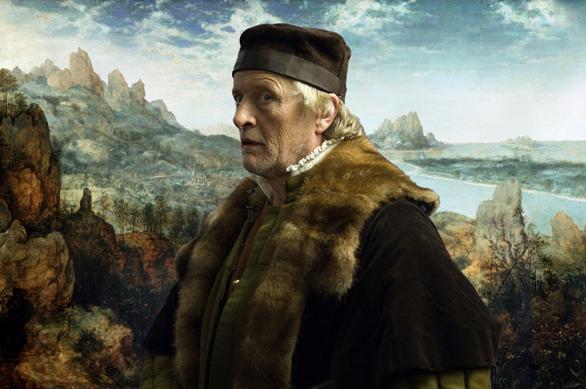|
Reviews of Recent Independent, Foreign, & Documentary Films in Theaters and DVD/Home Video

THE MILL AND THE CROSS Since the actual act of creation isn’t very compelling, films about artists, like writers, composers, or painters, often replace that essential moment of filling a page or a canvas with more dramatic visuals. Take Lech Majewski’s The Mill and the Cross, which focuses on 16th century Flemish master Pieter Bruegel’s The Way to Cavalry, which currently hangs in Vienna’s Kunsthistorisches Museum. Bruegel’s spirited work of art, set in a landscape populated by hundreds of people walking to the site of Christ’s crucifixion, is crammed with details both realistic and symbolic, much of which is indecipherable today to those who are not art experts.
Majewski’s film, based on co-screenwriter Michael Francis Gibson’s book, audaciously attempts to clarify some of the work’s arcane symbolism by bringing to life several characters who appear in the painting, along with Bruegel, his wife Marijken, and Nicholas Jonghelinck, the artist’s good friend and an important art collector. Majewski takes a radical approach to visualizing the creation and content of Bruegel’s densely packed painting. (You could comb it for hours just studying the interactions of its 500 characters). Although the artist himself isn’t shown with his paint brush on a canvas, his creative process is demonstrated through clever CGI effects that allow the actors to “enter” the painting right from the beginning. As characters move through the painting’s blue-screened landscape, Bruegel walks among them, explaining who’s who and what’s what.
That explanation introduces the film’s recurring flaw. As remarkable as the painting’s recreation is—along with the sumptuous cinematography by Majewski and Adam Sikora—there’s too much telling and not enough pondering its hidden ambiguities. For example, a brilliant early shot of a shimmering spider web covered in morning dew is mirrored by a later one of Bruegel sitting before that same web, followed by Bruegel’s description of his working method: “I will work like the spider this morning, building its web.” Showing that symbolic web twice is already overdoing it, but Bruegel acknowledging its significance to his artistry is utter redundancy.
In another example, Bruegel shows preliminary sketches to Nicholas, spelling out specifics about the painting in a risible “Flemish Paintings for Dummies” manner that’s helped by Nicholas asking obvious questions that allows for further explanations. It’s all eye-rolling enough, but when Bruegel stoops to pointing out the circles of life and death that are in the painting, the movie hurtles toward self-parody.
Majewski’s film is best seen as a snapshot of life 500 years ago (its subtitle should be ”A Day in the Life of the 16th Century”), showing how people walked on stilts and danced to a flute-like instrument, or how large families had to crowd together in their small houses and even smaller rooms. A sequence of a man being fallen upon and beaten to death by brutish men in red coats, then strung up to be pecked at by crows, brings a political undercurrent into what feels like a dry anthropological treatise.
Those red-jacketed men also appear in Bruegel’s painting as an allusion to the brutality of Flanders’ Spanish occupiers, circa 1564, the year he painted The Way to Cavalry. However, Majewski’s depicting this luckless man being killed then becoming bird food feels superfluous in the context of the painting, which only hints at Bruegel’s fellow countrymen’s suffering by merely showing several Spanish red coats. Instead, Majewski unaccountably wallows in the brutality by having the crows peck out the corpse’s eyes from various angles. Such scenes give the film a halting rhythm, as if Majewski, unsure what to concentrate on, ended up showing bits and pieces that never coalesce into a dramatically satisfying whole.
Such dramatic inertia surely hinders the actors, led by a sullen Rutger Hauer as Bruegel. It’s hard to believe that this man could muster enough energy to paint such a boisterous, massive canvas as the one we see being created. Michael York, who, as Nicholas, has the film’s first intelligible lines of dialogue 30 minutes in (unsurprisingly—and typically—he’s first heard explaining the back story of the Spanish occupation to orient viewers). He remains dignified in a thankless role, as does Charlotte Rampling as the Virgin Mary (seen in the lower right corner of the painting), adrift in a pointless parallel storyline.
Unable to approximate the vivid imagination on display in Bruegel‘s painting, The Mill and the Cross (which refers to two of the work’s most prominent images)
adds little to our understanding of the artist and his work. Even Peter Greenaway’s Nightwatching, which ran roughshod over Rembrandt’s The Night Watch,
was playful enough to mitigate its crimes against art history. Majewski throws up his arms in defeat in his film’s final image, a beautiful reverse tracking shot
beginning with a close up of the actual painting that becomes an expansive view of it and several other Bruegel masterworks in the Kunsthistorisches Museum
gallery. Maybe Majewski should have made a documentary overview of Bruegel’s paintings rather than this ambitious but failed attempt to explore the inner workings of one of them.
Kevin Filipski
|

